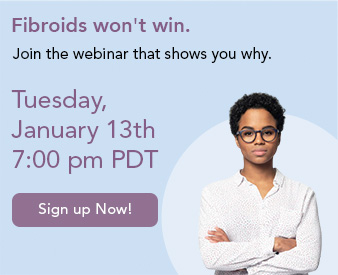Fibroid Treatment
A recent study from womanshealth.gov states: About 20 to 80 percent of woman develop fibroids by the time they reach age 50. The Fibroid Treatment Collective offers women a chance to treat fibroids without invasive fibroid surgeries or myomectomies. Located in Los Angeles, The Fibroid Treatment Collective has helped women across California and around the world with fibroid removal through uterine fibroid treatment.
When it comes to any type of fibroid treatment, your doctor should inform you of the risks, complications and possible side effects. The Fibroid Treatment Collective specializes in a non-surgical option; Uterine Fibroid Embolization, (UFE). Fibroid embolization is a non-invasive, outpatient procedure with low risk and minimal side effects. It does not involve the discomfort or long recovery time of surgery and is a proven, effective fibroids treatment.
Uterine Fibroid Embolization – Nonsurgical Fibroid Treatment
Embolization has existed as a medical procedure since 1975. In gynecology, it was used to reduce bleeding during uterine surgery. Founding members of the Fibroid Treatment Collective noticed another important effect. It shrank fibroids. The promise of an effective, non-invasive treatment led to research, trials and medical acceptance. Today more than several hundred thousand women worldwide have found relief with this safe, simple procedure. The Fibroid Treatment Collective performed the very first fibroid embolization in America in 1994 and has authored many important articles on the subject.
Benefits & Drawbacks
UFE is a simple, non-surgical treatment with a very quick recovery time. It offers immediate relief from excessive bleeding. Embolized fibroids cannot re-grow, because their blood supply has been eliminated. UFE does not disturb or damage uterine tissue. National and international studies indicate UFE does not impair fertility in patients of childbearing age. But there may be some post-procedure discomfort. Fibroid shrinkage can take up to six months. And most OB/GYNs aren’t certified to perform UFE, so patients are often referred to a radiologist.
Hysterectomy – Surgical
One type of fibroid surgery is hysterectomy. Fibroids are the most common cause for hysterectomy, they are associated with as many as 40% of more than 600,000 hysterectomies performed in the US annually. Depending on their location, fibroids can cause either heavy bleeding, pelvic and back pain, or pressure on bowel and bladder. Most hysterectomies performed for fibroids [the medical term is myoma] are performed by the abdominal route since the fibroids may grow to be quite large. Fibroids are almost never cancerous.
Benefits & Drawbacks
A hysterectomy eliminates fibroids. (No uterus, no uterine fibroids.) But hysterectomy is major surgery and like all surgeries, has potential risks and complications. Yes, a hysterectomy ends a fibroid problem. But also menstrual periods and the ability to conceive, carry or deliver a baby. For some women, this is acceptable. For others, removing a significant female organ is not the first choice in fibroid treatment.
Myomectomy – Surgical
Myomectomy is the surgical fibroid removal from the uterus. There are three basic approaches. Abdominal myomectomy removes fibroids through an incision in the abdomen. Laparoscopic myomectomy uses several very small incisions in the abdomen to remove fibroids. Hysteroscopic Myomectomy requires an instrument called a resectoscope, which is inserted vaginally and uses electrical current to cut tissue. This type of myomectomy should only be performed by physicians trained in the use of a resectoscope.
Benefits & Drawbacks
Myomectomy leaves the uterus intact. Menstruation and childbearing ability are preserved. But the possibility of fibroid regrowth is significant. 50% of all myomectomies need to be repeated. Your opportunity for pregnancy is limited by how quickly fibroids re-appear. Uterine scarring caused during surgery may hamper conception. Uterine walls weakened by myomectomy incisions may require a C-section during delivery.
Diet & Nutrition
A low-fat, high-protein diet may help slow fibroid growth and relieve some symptoms. How? Certain substances secreted by fat cells mimic the effects of estrogen. Estrogen is linked to the development of fibroids and fibroid growth. By limiting fat in your diet, you reduce fat cells and their ability to mimic estrogen. The high-protein part of this diet can be challenging. Protein sources such as factory-farmed eggs, dairy, meat, poultry, and fish often have high levels of estrogen. Many plant-based proteins such as soy products, beans, nuts, and yams are also estrogen rich.
Benefits & Drawbacks
No medication or surgery is required. There are overall health benefits of reducing fat and increasing protein in your diet. Still, most people find restrictive diets difficult to maintain. And estrogen is common in many foods. The amount of estrogen you can actually regulate through dietary changes may have little or no impact on fibroid symptoms.
Hormone Therapy for Fibroids
Female sex hormones play an important role in fibroid growth. Certain hormones and hormone combinations can be used to reduce fibroid symptoms such as heavy bleeding and period pain. Hormone therapy will not eliminate or ‘cure’ fibroids. It can only be prescribed for a limited amount of time, due to the risk of side effects.
Benefits & Drawbacks
Hormone therapy can provide symptom relief for heavy or painful periods. Some hormones may also shrink the fibroid and uterine size. But hormone therapy can only offer temporary relief. And side effects range from minor changes in mood and energy level to weight gain, acne, unwanted hair growth, anxiety, and hot flashes.
Radio Frequency Ablation (RFA) for Fibroids
A non-surgical procedure that destroys fibroid tissue with high-frequency energy. RFA utilizes a needle-like probe, inserted through a small abdominal incision. The probe is guided by laparoscopic and ultrasound imaging, then inserted into each fibroid and activated. High energy radio waves “heat” tissue and impair its function. In response to this damage, fibroids begin to shrink.
Benefits & Drawbacks
Out-patient means no hospital stay and minimal recovery time. Entry incisions are small and uterine tissue isn’t cut, removed or sutured. But this method of fibroid treatment is new and studies of its long-term efficacy are not yet available. The possibility of fibroid-regrowth is unknown. The procedure’s effect on fertility and childbearing has not been evaluated.
Do you have symptoms for fibroids?
If you are showing signs of fibroid symptoms and think you have fibroids, schedule an appointment for a professional diagnosis. One of our fibroid surgeons will talk to you about your symptoms and perform a pelvic exam. We may order further testing including an imaging procedure such as an ultrasound. If fibroids are diagnosed we will discuss the best fibroid treatment for you. Here at the Fibroid Treatment Collective, we offer free consultations in-office or over the phone. Feel free to contact us for more information. To learn more about fibroids, visit our homepage.
After Fibroid Embolization, Claudia Was Back to High Heels Within Days
Claudia was preparing herself for a major surgery to treat fibroids when she heard about the Fibroid Treatment Collective. After reading patient testimonials and visiting Dr. McLucas in LA, she learned that she could preserve her fertility and avoid surgery. One week later, she was pain-free, fibroid-free, and back to wearing high heels.


